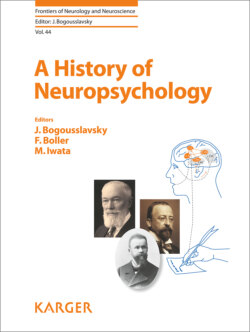Читать книгу A History of Neuropsychology - Группа авторов - Страница 69
Setting the Stage
ОглавлениеFranz Gall (1758–1828), an accomplished neuroanatomist linked to the pseudoscience of phrenology, observed physical features of the head and related these to mental faculties. While still a student, he famously associated protruding eyes with an excellent memory for words. During the early 19th century, Gall described regional anatomical variations in the human brain, which he associated with mental abilities and behaviors observed during life [5]. He proposed cerebral organs as the morphological substrates for an intellectual faculty, psychological trait, or moral tendency. Thus, Gall reasoned that brain tissue behind the orbits represented organs for word memory and language sense, and their enlargement led to protruding eyes [5]. Gall did not identify organs for writing or reading. His controversial doctrines were popular throughout the 19th century but were opposed by the Catholic Church and by the scientific establishment.
Beginning in 1825, the French physician Jean–Baptiste Bouillaud (1796–1881) reported series of patients who had lost the ability to speak but understood what was said to them. At autopsy, he described areas of injury within the anterior (frontal) lobes, and Bouillaud proposed that a “special cerebral center…distinct and independent” (p 42) was responsible for speech [6]. This interpretation accorded with Gall’s organ for language sense, which Gall had located within a more delimited portion of the anterior lobes [5].
Building on Bouillaud’s work, Louis Victor Marcé (1828–1864) in 1856 described patients whose speech or writing was impaired; 2 patients wrote well despite speaking poorly [7]. By way of explanation, Marcé proposed that the agent responsible for speech coordination, but not the agent for writing coordination, had been damaged. These cases implied that a brain faculty coordinated the graphic representation of ideas, the formation of letters, and the assembly of letters into syllables and words. The role of this writing faculty was analogous to the speech center described by Bouillaud [6]. Marcé recognized, as had Bouillaud, that speech and writing were usually impaired together after brain injury. He reasoned that the speech and writing faculties were separate but intimately connected, but Marcé did not propose anatomically distinct centers.
